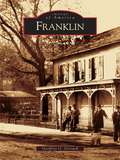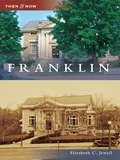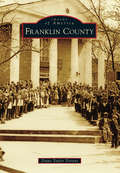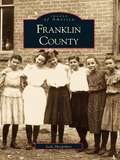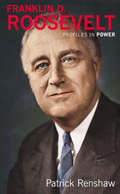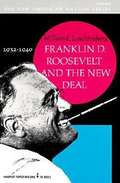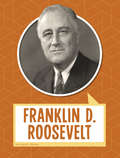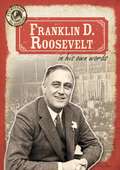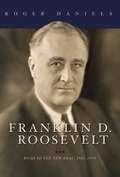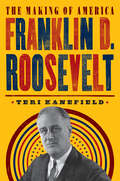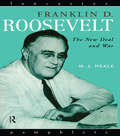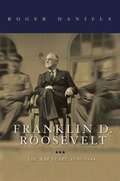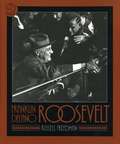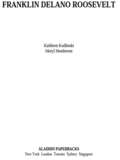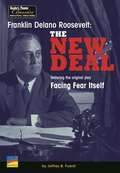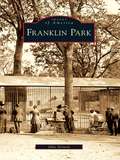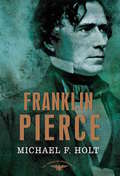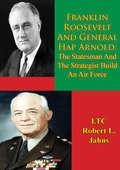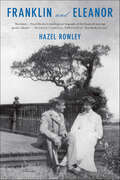- Table View
- List View
Franklin (Images of America)
by Geoffrey G. GorsuchFranklin was first established in 1796 as a sleepy collection of cabins along the beautiful Great Miami River. When the Miami Canal came through the village in 1829, and the railroad followed in the 1870s, many new industries came to the area, and the downtown filled with fine brick and stone residences, businesses, churches, and public buildings. The town prospered through the 19th century, and the proud community's leaders proclaimed a grand celebration of its past, present, and envisioned future: the FranklinHomecoming of 1910. Just three years later, Franklin was struck by the greatest calamity in its history, the Flood of 1913. Though Franklin quickly recovered, it soon left its past behind, as it became a modern city in a rapidly changing nation. Through vintage images of buildings, businesses, and people now gone and forgotten, Franklin brings to life the town's rich history, from its beginnings to 1920.
Franklin (Then and Now)
by Elizabeth C. JewellFranklin, incorporated in 1895, is New Hampshire's smallest city and is situated where the Pemigewasset and Winnipesaukee Rivers form the headwaters of the Merrimack River. Long known as the "Gateway to the White Mountains," Franklin was once a thriving tourist destination and a bustling mill town. These deep and varied roots inspired resident Elizabeth C. Jewell to document the city's development. Franklin continues to look towards the future and remains respectful of its past.
Franklin County
by Diane Taylor TorrentFranklin County is situated in the northeastern Piedmont region of North Carolina. Known for its fruitful soil, rolling hills, and bountiful streams, it has a rich agricultural heritage. Franklin County was created in 1779, with its founders honoring statesman Benjamin Franklin as the county's namesake. Built along the Tar River, Louisburg, the county seat, has an impressive historic district lined with majestic homes and churches from the turn of the 20th century. Steeped in education, Franklin County is home to Louisburg College, which was established in 1787, and once boasted as many as 100 one-room schoolhouses. Franklin County showcases the architectural heritage, long-standing communities, and citizens who have lived and worked here.
Franklin County
by Lola ShropshireCreated from a portion of Crawford County in 1837, Franklin County is divided by the Arkansas River into two sections, each with its own county seat: Ozark in the North and Charleston in the South. Northern Franklin County is remote, mysterious, and beautiful, while the southern area enjoys graceful and vastly productive prairie lands. The combination of fertile soil and mild climate in the Ozark Mountains produces fruit, vineyards, precious stones, granite, and forests. Evocative images such as the young girls posing in the Altus schoolyard paint a poignant and revealing picture of everyday life in Franklin County. Coal mining played a large part in the lives of residents, and photographs of soot-covered miners display the hardships of this difficult work. With over two hundred photographs gathered from local collections, this book illustrates the history and culture of Franklin County in vivid detail, with captions that are both entertaining and informative.
Franklin D Roosevelt (Profiles In Power)
by Patrick RenshawAn important addition to the Profiles in Power series, this critical biography looks at Franklin D. Roosevelt, the most dominant US politician of the 1930s and 1940s. Roosevelt led the United States through the two great crises of depression and the Second World War, making him one of the key figures of the twentieth century.
Franklin D Roosevelt and the New Deal 1932 -1940
by William E. LeuchtenburgWhen the stability of American life was threatened by the Great Depression, the decisive and visionary policy contained in FDR's New Deal offered America a way forward. In this groundbreaking work, William E. Leuchtenburg traces the evolution of what was both the most controversial and effective socioeconomic initiative ever undertaken in the United States -- "and explains how the social fabric of American life was forever altered. It offers illuminating lessons on the challenges of economic transformation -- "for our time and for all time.
Franklin D. Roosevelt (Biographies)
by Laura K. MurrayHow much do you know about Franklin Roosevelt? Find out the facts you need to know about the 32nd president of the United States. You'll learn about the early life, challenges, and major accomplishments of this important American.
Franklin D. Roosevelt (Great Lives Series): The People's President (Great Lives Series)
by John W. SelfridgeWitness history in the making as you turn the pages of time and discover the fascinating lives of famous explorers, leaders of twentieth-century politics and government, and great Americans. &“The only thing we have to fear is fear itself.&” With these resounding words and innovative, often controversial, programs Franklin D. Roosevelt stirred a nation to confront and triumph over the Great Depression of the 1930s, the gravest domestic crisis since the Civil War. Roosevelt then led the U.S. to victory over twin menaces from abroad—Nazi Germany and Japan—in World War II. It was a dazzling display of sustained, imaginative leadership that changed the presidency, and the country, forever. Franklin D. Roosevelt: The People&’s President depicts the life and times of one of America&’s best-loved presidents. Roosevelt paid little heed to his personal adversity—the polio that crippled his legs. Listen to his radio addresses—the famed &“fireside chats&”—and see how he showed the American people just how much a president can do.
Franklin D. Roosevelt in His Own Words
by John SheaFranklin D. Roosevelt was one of the most powerful and popular US presidents. He was the only one to serve 12 years and was elected four times. As the leader of the nation, he saw the country through an economic depression and World War II. Through primary sources, personal and political writings, and quotations, readers will become familiar with the man behind the famous name, from his early life to his momentous presidency. This book is a unique way to examine US history in the early twentieth century through the biography of one remarkable man.
Franklin D. Roosevelt: A Political Life
by Robert Dallek“In a period defined by division, gridlock and tweet storms, Dallek crafts a pointillist portrait of the four-term president” —Peter M. Gianotti, Newsday“Will rank among the standard biographies of its subject” —Publishers WeeklyA one-volume biography of Roosevelt by the #1 New York Times bestselling biographer of JFK, focusing on his career as an incomparable politician, uniter, and deal maker In an era of such great national divisiveness, there could be no more timely biography of one of our greatest presidents than one that focuses on his unparalleled political ability as a uniter and consensus maker. Robert Dallek’s Franklin D. Roosevelt: A Political Life takes a fresh look at the many compelling questions that have attracted all his biographers: how did a man who came from so privileged a background become the greatest presidential champion of the country’s needy? How did someone who never won recognition for his intellect foster revolutionary changes in the country’s economic and social institutions? How did Roosevelt work such a profound change in the country’s foreign relations? For FDR, politics was a far more interesting and fulfilling pursuit than the management of family fortunes or the indulgence of personal pleasure, and by the time he became president, he had commanded the love and affection of millions of people. While all Roosevelt’s biographers agree that the onset of polio at the age of thirty-nine endowed him with a much greater sense of humanity, Dallek sees the affliction as an insufficient explanation for his transformation into a masterful politician who would win an unprecedented four presidential terms, initiate landmark reforms that changed the American industrial system, and transform an isolationist country into an international superpower. Dallek attributes FDR’s success to two remarkable political insights. First, unlike any other president, he understood that effectiveness in the American political system depended on building a national consensus and commanding stable long-term popular support. Second, he made the presidency the central, most influential institution in modern America’s political system. In addressing the country’s international and domestic problems, Roosevelt recognized the vital importance of remaining closely attentive to the full range of public sentiment around policy-making decisions—perhaps FDR’s most enduring lesson in effective leadership.
Franklin D. Roosevelt: Road to the New Deal, 1882-1939
by Roger DanielsFranklin D. Roosevelt, consensus choice as one of three great presidents, led the American people through the two major crises of modern times. The first volume of an epic two-part biography, Franklin D. Roosevelt: Road to the New Deal, 1882-1939 presents FDR from a privileged Hyde Park childhood through his leadership in the Great Depression to the ominous buildup to global war. Roger Daniels revisits the sources and closely examines Roosevelt's own words and deeds to create a twenty-first century analysis of how Roosevelt forged the modern presidency. Daniels's close analysis yields new insights into the expansion of Roosevelt's economic views; FDR's steady mastery of the complexities of federal administrative practices and possibilities; the ways the press and presidential handlers treated questions surrounding his health; and his genius for channeling the lessons learned from an unprecedented collection of scholars and experts into bold political action. Revelatory and nuanced, Franklin D. Roosevelt: Road to the New Deal, 1882-1939 reappraises the rise of a political titan and his impact on the country he remade.
Franklin D. Roosevelt: The Making Of America #5 (The Making of America)
by Teri KanefieldThis biography for young readers explores the life of the thirty-second president, who lifted the United States from depression to global leadership.When Franklin D. Roosevelt was first elected president in 1933, America was in the throes of the Great Depression—the worst economic crisis in U.S. history—and the world was experiencing a menacing rise in Nazism and other dangerous extremists. Throughout his four presidential terms, Roosevelt was a steady and inspiring leader. He implemented progressive social reform through his New Deal agenda and helped lift America from economic crisis. He guided America to victory in World War II. Born into wealth and privilege, Roosevelt entered politics at a young age. His career and world views were shaped by his marriage to Eleanor Roosevelt and his long struggle with polio. Franklin Delano Roosevelt, our thirty-second president, forever left his mark on our nation and the world. By the time of his death, America had grown to a global economic and military superpower. His New Deal legislation changed the relationship of American citizens to their government. His policies came close to fully realizing Alexander Hamilton’s vision of a government that touches and improves the lives of all citizens.The book includes selections from Roosevelt’s writings, endnotes, a bibliography, and an index.“Kanefield provides readers with an intimate examination of Franklin Delano Roosevelt. . . . It flows in a friendly and welcoming style that reluctant readers will appreciate. . . . A solid account for both history buffs and report-writers.” —Kirkus Reviews“Neither hagiography nor a hatchet job, this evenhanded overview of FDR walks a middle path perfect for middle grade readers. A commendable addition to school and public library collections.” —School Library Journal
Franklin D. Roosevelt: The New Deal and War (Lancaster Pamphlets)
by Michael HealeThis compact study assesses the personality, political and economic policies in war and peace, of America's longest-serving president and one of the most important political figures of the twentieth century, Franklin. D. Roosevelt. Also providing an overview of the America over which Roosevelt presided, the book offers a concise survey of both domestic and foreign affairs.
Franklin D. Roosevelt: The War Years, 1939-1945
by Roger DanielsHaving guided the nation through the worst economic crisis in its history, Franklin Delano Roosevelt by 1939 was turning his attention to a world on the brink of war. The second part of Roger Daniels's biography focuses on FDR's growing mastery in foreign affairs. Relying on FDR's own words to the American people and eyewitness accounts of the man and his accomplishments, Daniels reveals a chief executive orchestrating an immense wartime effort. Roosevelt had effective command of military and diplomatic information and unprecedented power over strategic military and diplomatic affairs. He simultaneously created an arsenal of democracy that armed the Allies while inventing the United Nations intended to ensure a lasting postwar peace. FDR achieved these aims while expanding general prosperity, limiting inflation, and continuing liberal reform despite an increasingly conservative and often hostile Congress. Although fate robbed him of the chance to see the victory he had never doubted, events in 1944 assured him that the victory he had done so much to bring about would not be long delayed. A compelling reconsideration of Roosevelt the president and campaigner, The War Years, 1939-1945 provides new views and vivid insights about a towering figure--and six years that changed the world.
Franklin D.Roosevelt and Abraham Lincoln: Competing Perspectives on Two Great Presidencies (Library Of Franklin D. Roosevelt Studies #Vol. 5)
by William D. Pederson Michael R WilliamsAbraham Lincoln and Franklin D. Roosevelt are widely considered the two greatest presidents of the past two centuries. How did these two very different men rise to power, run their administrations, and achieve greatness? How did they set their policies, rally public opinion, and transform the nation? Were they ultimately more different or alike? This anthology compares these two presidents and presidencies, examining their legacies, leadership styles, and places in history.
Franklin D.Roosevelt and the Formation of the Modern World (Library Of Franklin D. Roosevelt Studies #Vol. 4)
by William D. Pederson Steve HowardNo event shaped the twentieth century more than World War II, and no leader shaped the conduct of the war and the formation of the modern world more than President Franklin D. Roosevelt. In this anthology, leading scholars examine Roosevelt's role in the international arena, focusing on his diplomacy with Europe, Russia, the Baltic States, Canada, and the Caribbean; his relations with American Jews in the face of the Holocaust; his military appointments; and the operation of the Civilian War Services Division.
Franklin Delano Roosevelt
by Russell Freedman"As in Lincoln: A Photobiography (Clarion, 1987), Freedman has taken a larger-than-life historical figure about whom innumerable volumes have been written and has retold the story of one man's life in the context of his times. The carefully researched, highly readable text and extremely effective coordination of black-and-white photographs chronicle Roosevelt's priviledged youth, his early influences, and his maturation. Drawing on first-hand observations of his family, friends, and enemies, as well as Roosevelt's own diary entries, Freedman formulates a composite picture of a complex, enigmatic individual and a consummate politician. Roosevelt's public career is given further significance because of the cataclysmic events of the Depression and the tumultuous war years during his presidency. As controversial as many of his programs and policies were or have come to be, no one could ever call to question his dedication, his initiative, or the energy he brought to the job. His all too human shortcomings are just as clearly delineated. Even students with little or no background in American history will find this an intriguing and inspirational human portrait." <br>-School Library Journal
Franklin Delano Roosevelt for Kids: His Life and Times with 21 Activities
by Richard PanchykFranklin Delano Roosevelt's enduring legacy upon the history, culture, politics, and economics of the United States is introduced to children in this engaging activity book. Kids will learn how FDR, a member of one of the founding families of the New World, led the nation through the darkest days of the Great Depression and World War II as 32nd U.S. President. This book examines the Roosevelt family--including famous cousin Teddy Roosevelt and First Lady Eleanor Roosevelt--as well as FDR's early political career and subsequent 12 years in office during some of the most fascinating and turbulent times in American history. Interspersed throughout are first-hand accounts from the people who knew FDR and remember him well. Children will also learn how his personal struggles with polio and his physical disability strengthened FDR's compassion and resolve. In addition, kids will explore Roosevelt's entire era through such hands-on activities as staging a fireside chat, designing a WPA-style mural, sending a double encoded message, hosting a swing dance party, and participating in a political debate.
Franklin Delano Roosevelt: Champion of Freedom (Childhood of Famous Americans Series)
by Kathleen V. KudlinskiThis childhood biography of the 32nd president of the United States explores the events that shaped the tenacious character of a young Franklin Delano Roosevelt.
Franklin Delano Roosevelt: The New Deal, Featuring the Original Play, Facing Fear Itself
by Jeffrey B. Fuerst Alfredo BelliNIMAC-sourced textbook
Franklin Park
by Julie ArrisonFranklin Park was meant to be the crown jewel of the Emerald Necklace, Boston's famed park system. It was also meant to be the epitome of Frederick Law Olmsted's distinguished career as the father of American landscape architecture. Its 527 acres of open space have been a salvation from urban plight and also the center of urban controversy. Today the community around the park remains strong and depends upon the work of volunteers, advocacy groups, and the City of Boston. The photographs in Franklin Park have been collected from a variety of personal collections and public archives in an effort to illustrate the park's history from its inception in the 1880s through its rebirth in the 1990s.
Franklin Pierce: The American Presidents Series: The 14th President, 1853-1857
by Michael F. HoltCharming and handsome, Franklin Pierce of New Hampshire was drafted to break the deadlock of the 1852 Democratic convention. Though he seized the White House in a landslide against the imploding Whig Party, he proved a dismal failure in office. <P><P> Michael F. Holt, a leading historian of nineteenth-century partisan politics, argues that in the wake of the Whig collapse, Pierce was consumed by an obsessive drive to unify his splintering party rather than the roiling country. He soon began to overreach. Word leaked that Pierce wanted Spain to sell the slave-owning island of Cuba to the United States, rousing sectional divisions. Then he supported repeal of the Missouri Compromise, which limited the expansion of slavery in the west. Violence broke out, and "Bleeding Kansas" spurred the formation of the Republican Party. By the end of his term, Pierce's beloved party had ruptured, and he lost the nomination to James Buchanan. <P><P> In this incisive account, Holt shows how a flawed leader, so dedicated to his party and ill-suited for the presidency, hastened the approach of the Civil War.
Franklin Roosevelt And General Hap Arnold: The Statesman And The Strategist Build An Air Force
by LTC Robert L. JahnsStatesman and soldiers: What is the relationship that exists between the policymaker and the strategist? And, when the policymaker is actively involved in determining the strategies, what is the effect of advice given by the senior military leader and what role should he play in formulating policy and strategy? Given that military officers will continue to provide advice and service to civilian leaders, how do these relationships between the statesman and strategist influence or shape the outcome of policymaking, and can successes or failures be attributed to these personal relationships? This study seeks to examine those questions by reviewing the relationship of the somewhat controversial General Hap Arnold and the President of the United States, Franklin Delano Roosevelt. The study will initially focus on the strategist, General Arnold, as he developed personally, and some of the background history and politics in the development of the Army Air Forces. Approaching the World War II era, the focus will shift to the building of the world's greatest air force and the winning of World War II. It will examine the personalities, politics, and policies of the President of the United States in their relationship to General Arnold and other service chiefs. The paper will conclude with thoughts on the relationships between policymakers and strategists to determine if those relationships are still important today and if so, how the strategist can best prepare for this relationship.
Franklin and Eleanor Roosevelt in Albany: Governing New York (The History Press)
by Michael J. BurgessFranklin and Eleanor Roosevelt changed America with a government on the side of the people that put Americans back to work and inspired confidence that the nation could overcome the Great Depression. This is the story of their progressive legacy when FDR was Governor during the era of Prohibition and the advent of radio in the Roaring Twenties, a decade that ended with the Great Depression upending life for most Americans. This is the story of how as Governor of New York he tried the programs that became the New Deal that transformed America. It was the place where his warm, easily relatable voice heard on the radio for the first time created a bond of trust with the public that inspired confidence at a time of great fear.Author Michael J. Burgess reveals the often overlooked history of Franklin and Eleanor Roosevelt in Albany at the helm of the Empire State.
Franklin and Eleanor: An Extraordinary Marriage
by Hazel Rowley“Revelatory. . . . [This] crackling new biography of the Roosevelt marriage speaks volumes.” —Maureen Corrigan, NPR’s Fresh Air, Best Books of 2010Franklin Delano and Eleanor Roosevelt’s marriage is one of the most celebrated and scrutinized partnerships in presidential history. It raised eyebrows in their lifetimes and has only become more controversial since their deaths. From FDR’s lifelong romance with Lucy Mercer to Eleanor’s purported lesbianism—and many scandals in between—the American public has never tired of speculating about the ties that bound these two headstrong individuals. Some claim that Eleanor sacrificed her personal happiness to accommodate FDR’s needs; others claim that the marriage was nothing more than a gracious façade for political convenience. No one has told the full story until now.In this groundbreaking new account of the marriage, Hazel Rowley describes the remarkable courage and lack of convention—private and public—that kept FDR and Eleanor together. She reveals a partnership that was both supportive and daring. Franklin, especially, knew what he owed to Eleanor, who was not so much behind the scenes as heavily engaged in them. Their relationship was the product of FDR and Eleanor’s conscious efforts—a partnership that they created according to their own ambitions and needs.In this dramatic and vivid narrative, set against the great upheavals of the Depression and World War II, Rowley paints a portrait of a tender lifelong companionship, born of mutual admiration and compassion. Most of all, she depicts an extraordinary evolution—from conventional Victorian marriage to the bold and radical partnership that has made Franklin and Eleanor Roosevelt go down in history as one of the most inspiring and fascinating couples of all time.
